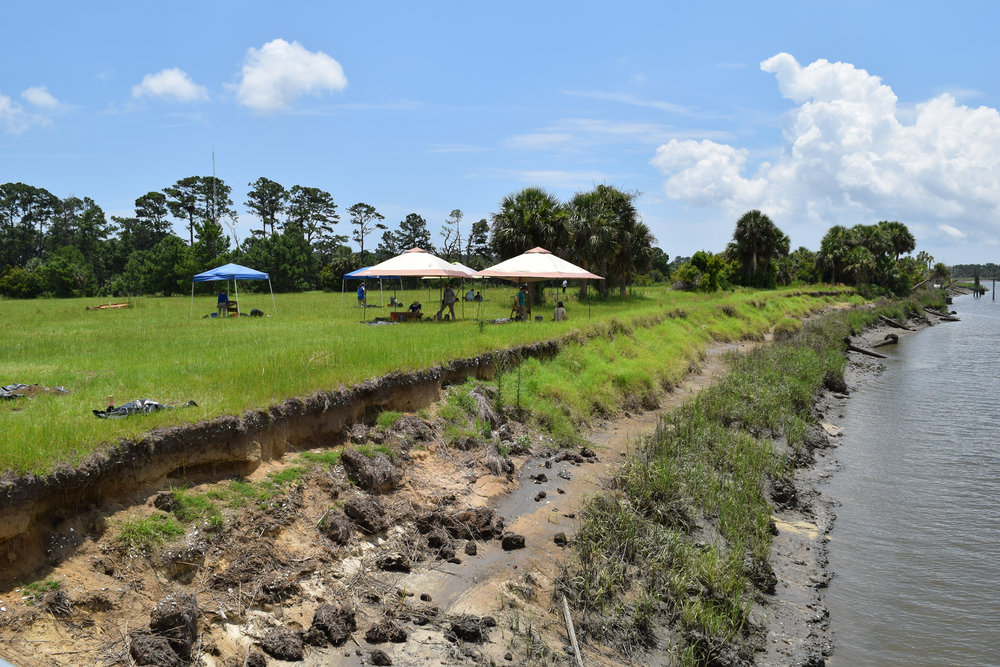
Caption
Ossabaw Island, seen here partially eroded after Hurricane Michael in 2018, is among the coastal regions at risk of cultural heritage loss, according to new research.
Credit: University of Georgia Laboratory of Archaeology
LISTEN: A new scientific paper quantifies the “great risk” to cultural heritage in Coastal Georgia. GPB's Benjamin Payne reports.

Ossabaw Island, seen here partially eroded after Hurricane Michael in 2018, is among the coastal regions at risk of cultural heritage loss, according to new research.
As human-caused climate change intensifies the severity of hurricanes and accelerates the rate of sea level rise, more than 4,000 archaeological sites in Coastal Georgia stand at risk of partial damage — or complete loss, according to a new scientific study.
Publishing their findings in the peer-reviewed journal PLOS ONE, archaeology professors Victor Thompson of the University of Georgia and Matthew Howland of Wichita State University used computer modeling to estimate the vulnerability of material cultural heritage along Georgia's Atlantic coastline and nearby inland areas.
“Our analysis projects that the vast majority of archaeological sites within 40 kilometers (about 25 miles) of the Georgia coast are currently at risk of damage through inundation, erosion, or accretion from storm surge events that, though unpredictable, could occur at any time,” the researchers wrote.
More than 10 times as many sites are at risk than previously thought, Thompson and Howland wrote, since their new study looked at sea level rise (SLR) not in isolation but rather in tandem with storm surge.
At the current sea level, the tolls ranges from as few as 953 sites damaged under tropical storm conditions to as many as 4,290 sites in the event of a Category 5 hurricane.
That range worsens under three progressively taller heights of global average SLR: at a relatively low 0.3 meters, 1,201 to 4,658 sites are endangered; at a medium rise of 1 meter, it expands to 1,615 to 4,791; and at a high rise scenario of 2 meters, it balloons to between 1,898 and 4,892 sites.
“In addition to important Indigenous Native American cultural sites, the Georgia coast is host to a number of culturally significant Spanish missions, Euromerican plantations, and colonial forts,” the study stated. “These sites tend to be located along the edges of tidal creeks, marshlands, and coastal sounds, making them particularly vulnerable to SLR.”
As an example of a location at high risk of loss to its cultural heritage, Thompson brought up the south end of Chatham County's Ossabaw Island, which has already seen erosion caused mainly by Hurricane Michael in 2018.
“There's a vulnerable site there where we can lose up to almost a meter's worth of shoreline a year — all of which has cultural resources that are eroded out,” Thompson told GPB. “When storms come through, it's accelerated.”
But while the study foresees a bleak reality — that future storm surge “likely exceeds” preservationists' capacity to protect archaeological sites — it is still possible to mitigate the damage, but only with advance preparation.
To that end, the researchers shared their detailed results with the Georgia Historic Preservation Division, which Thompson hopes will use the data to best allocate the state's limited resources.
The study gives the agency “a sense of how to plan for these kinds of things,” he said. “It gives us a sense of what do we need to target in terms of thinking about preservation and conservation.”